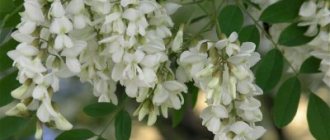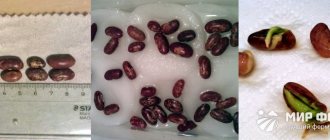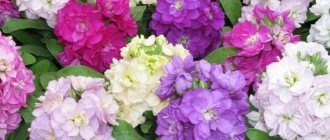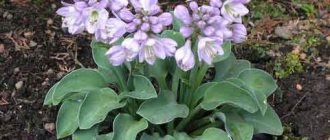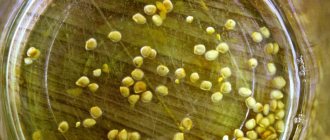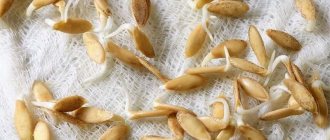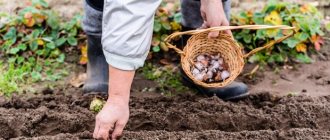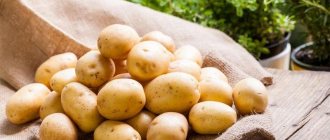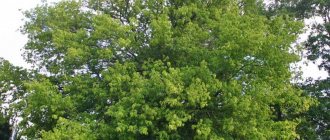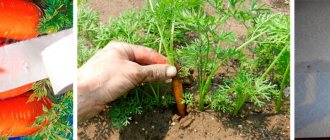When arranging our own garden, each of us pursues our own goals. So, the decision to plant a birch tree may have several reasons. The white trunk and graceful branches will become a magnificent decoration of the site; every spring you can collect healthy and tasty birch sap; if you have plans to build a bathhouse, then birch brooms will always come in handy. For this, one seedling purchased at a garden center will be enough. But what to do if you want to arrange mass plantings of birch, for example, as a living fence for your territory, to create a birch alley, or if you decide to create a birch nursery. Of course, you will have to learn how to grow birch seedlings yourself, from seeds. But let’s immediately make a reservation that growing birch seedlings is fraught with significant difficulties: small birch seeds with shallow planting and its delicate shoots with their superficial root system require careful but constant care.
The first thing to start with is preparing the seeds. Since birch seeds fall very quickly, it is necessary to very carefully monitor the change in color of birch catkins. To check their maturity, rub the earring with your hand and if the seeds begin to fall off, you should collect the branches and tie them into a bundle. Such bunches are hung in a dry and, most importantly, protected from the wind place for further ripening. After about a week, the seeds are carefully shaken out over the sheet, cleaned of debris and left for another 7 days. It is advisable to do sowing in the same autumn when the seeds were collected. Since germination rate will gradually decrease with each subsequent year.
Choosing a place
We must remember that birch loves water very much. A tree can pull almost 20 buckets from the soil per day. It takes root well in poor areas, solonetzes, chernozems, sands and loams. But it is best to choose areas where the soil is predominantly slightly acidic and loose, loamy and always well moistened.
Therefore, select a place, and if the soil is not very suitable, then you should prepare a planting hole, that is, add a mixture of sand, peat, humus and garden soil to it. In spring you will need one glass of complex fertilizer. But before planting, you need to take care to collect birch seeds. This can be done in early autumn.
Propagation by seedlings
If you don’t have a long time left, but want to plant a birch tree this season, then you can change your tactics. In this case, you need to go to the forest, or, more precisely, to a birch grove. It is best to organize a trip for a young seedling in early spring, when the leaves have not yet had time to bloom. It is necessary to find a young, strong sprout, up to 100 cm in size. There should be no twisted branches or signs of disease on it. Such a plant will easily take root and quickly begin to grow.
Updated 2 years ago
101 likes
4 don't like it
Birch is a beautiful tree, so many people want to have it in their garden. Most people think that it needs constant care, so they give up their dream, but knowing how to grow a birch tree, you can make your wish come true and admire the tree every day. To grow a birch tree from a branch on your site, you will need to select a suitable shoot, put it in water and wait until the root system is formed, then it should be planted in the ground. From time to time you need to water and not forget about fertilizing, otherwise the plant will die and you will have to start all over again.
Branch selection. To grow a birch tree, it is recommended to choose a suitable branch. The cuttings should be young, but already sufficiently developed. You should take a pruner and cut it at an angle of 30 degrees. The length of the branch should be up to 30 cm. The cutting should be taken from a young, healthy plant, then the future tree will be less susceptible to various diseases. The branch should be cut in the spring, when the buds are slightly swollen. In winter, this should not be done, since it will be impossible to plant the seedling in the soil; it will simply freeze. It is also not recommended to do this in summer and autumn.
Formation of the root system. To grow a birch tree from a branch, you need to place it in a glass of water and cover it with damp gauze to form a root system. It is recommended to change the fluid every 3 days. This may take about a month. To make the process go faster, gardeners recommend treating the lower part of the cutting with Kornevin. In this case, the roots will grow much faster. After just 2 weeks, the cuttings will be ready for planting. It may also happen that the root system does not form, so it is better to cut off a few branches and place them in a glass of water.
Landing in the ground. Growing a birch tree from a branch is not easy, because the cuttings are very capricious and require attention. As soon as a root system is formed on it, it is necessary to plant it in the ground, but not in the garden, but use a pot. You should mix the soil with sand, make a small depression and plant it in it, covering it with soil. The shoot must spend at least 5 months in the pot. During this time, the seedling will take root and become stronger. In order for it to grow healthy, you need to water it 2-3 times a week and protect it from direct sunlight. When autumn comes, you can plant it in the ground.
Planting in the garden. It is not difficult to grow a birch tree from a mature cutting. It is necessary to find a suitable place in the garden for the future tree, dig a hole and plant the plant. It is very important to treat the root system with care: if it is damaged, the seedling will die. After planting, it is recommended to water the tree for 4 days. In 1-2 months, the cuttings should take root and adapt to new conditions. It is quite easy to grow a birch tree from such a seedling; it will survive the winter cold and will subsequently delight you with its appearance.
Watering, fertilizing. To grow a birch tree, you need to water it regularly. This tree consumes quite a lot of water, so you should water it in the summer at the rate of 1 bucket per square meter. m. crown. Don't forget about feeding. In spring, it is recommended to add compost or humus to the soil. Birch tolerates nitrogen fertilizers well, but do not add too much of them. To grow a birch tree, you need to weed the ground around the tree. Weeds can deprive it of moisture. Do not forget about loosening the soil, but you should not dig the ground deeply.
Adviсe
- It is impossible to grow a birch tree without pest control. Gardeners recommend spraying the tree crown and trunk with fungicides and insecticides once a year. This kind of prevention will allow you to forget about insects.
Did you like the article?
Not really
Planting a birch tree is an excellent solution for arranging a personal plot or cottage. With its characteristic slenderness and black and white bark, it looks great in the yard. Caring for birch does not require any special skills. The tree does not need fertilizing, but it does require abundant watering. However, there are several other features of planting and caring for a tree, both on a personal plot and in the country. Let's look at how to plant a birch tree correctly and what needs to be done for its subsequent care.
Protection against diseases
Birch from seeds at home grows quite easily, but care must be taken to ensure that the planting is not destroyed by a fungus or other disease. Therefore, before placing them in the soil, they must be pickled. For this purpose, potassium permanganate or hydrogen peroxide is used. Seeds are placed in a one percent solution for 20 minutes. After this, they are washed and dried. There are special industrial preparations that help protect plantings from fungi and viruses, strengthen the immunity of future plants and give the sprout all the necessary nutrients.
Planting Instructions
Location on
A tall and slender birch tree can easily become a decoration for a garden or personal plot. It is undemanding to the soil, but needs a lot of moisture. It literally sucks out any water within a radius of about 10 meters around the trunk. Therefore, before planting, you need to choose a place where ornamental or agricultural crops do not grow.
At first, a birch sprout seems small and fragile, but over time it turns into a tall, powerful tree, so you should choose the planting site wisely. A distance of 4 m from gas and water pipes and building foundations should be maintained. If there is not much space on the site, then you can choose one of the decorative types of birch. Among them there are low (7-8 m) trees that can coexist with other plants in a limited area. Of course, such trees do not grow in our forests, and seedlings will need to be purchased from nurseries.
Tree from the forest
If you can afford to plant a full-fledged birch tree at your dacha, then the easiest way is to grow it from the forest. In this case, the most important step will be to find a small seedling. Inexperienced gardeners who want to quickly grow a tree often plant fairly mature seedlings, 1-1.5 m tall. But in most cases, such a tree does not live long in your dacha.
The fact is that at this age the plant already has a fairly extensive root system. To replant it painlessly, you need to dig up the plant along with a lump of soil with a volume of about 1 square meter. m, which is an impossible task.
When going in search of a seedling, you need to look for the smallest plants. A good choice would be a tree 50-60 cm high, but ideally it is better to find a very young one, about 20 cm in height, because it is the easiest to grow. When digging, it is necessary to step back from the trunk by 30-40 cm and, if possible, save as much earth as possible (at least 10 liters). It is also recommended to note the location of the tree relative to the cardinal directions, and plant it on the site in the same way.
The planting site should be well lit, but in the first few days it is better to shade the sprout a little. It is also necessary to immediately water the plant abundantly, and if the first few days after planting are hot, then watering must be continued. When planting, do not forget that in a few years it will be a massive tree with a wide crown. Consider whether it will disturb your neighbors by shading their area or sucking water and minerals from the soil. It is better to immediately assess the situation, how much territory your tree needs, in order to avoid conflicts in the future and grow it correctly; the plant lives for a very long time.
Planting from seeds
A more time-consuming, but at the same time reliable way to grow birch is to plant seeds. They can be bought or collected in the autumn. You can tell that the seeds are ripe by running your hand over the earring. If this causes them to begin to crumble, then you can collect several earrings and tie them into a “broom”. After this, the earrings dry out within 7 days and the seeds can be shaken out of them.
It is advisable to plant the seeds in the same autumn when they were collected. Before planting, it is recommended to treat them with an antifungal agent and clear the soil of any weeds. In the first days after planting, it is necessary to regularly water the seeds, and in winter, cover the planting site with snow.
Sources used:
- https://sornyakov.net/trees/semena-berezy.html
- https://dacha-posadka.ru/doma/kak-vyraschivat-berezu-v-domashnih-usloviyah.html
- https://kvetok.ru/listvennye-derevya/bereza-pushistaya-ili-povislaya
- https://7dach.ru/silva/bereza—klassika-dachnyh-uchastkov-posadka-uhod-5215.html
Stratification
Before planting, seeds must undergo cold treatment. To do this, you can keep them for 3-4 weeks in the refrigerator, and then dry them at room temperature. It is recommended to sow them in frozen soil at the beginning of winter or early spring. The seeds are placed directly on the surface, without burying, but only covered with a board. They can be pressed on top with small branches and watered. As soon as the first shoots appear, be sure to remove the covering. Birch seeds also spread independently, so don’t be surprised if a young sprout suddenly appears on your site at the beginning of summer. If it interferes, then in the fall you can carefully transplant it to a more suitable place.
Where to plant seeds: in containers or in beds
Birch seeds can be planted both in containers and in a garden bed, that is, in open ground.
We grow seedlings in containers
The time for planting in containers is the end of February and the beginning of March. At this time, the collected seeds are soaked for 15 minutes in potassium permanganate (in a fabric bag), washed and then scattered on top of a damp substrate in a container.
A soil mixture of peat and sand in a 1:1 ratio is used as a substrate. If the soil mixture is purchased at a garden store, it is poured without pre-treatment. If the soil mixture is prepared independently from chernozem and sand, it requires preliminary steaming.
The steaming-warming procedure is necessary to “neutralize” weed seeds. Birch produces small shoots similar to grass. Weed seeds present in chernozem can “suppress” small birch seedlings and choke out “unborn” trees. In order to prevent this, the earth is heated in the oven.
Heating of the earth is carried out at a temperature of +100° ... +160°C in a metal container, in an oven, oven. The container with soil is kept for about 30-40 minutes or an hour (depending on the amount of soil in the container). It is necessary to warm the ground until steam forms.
Note: in order to see that all the soil has warmed up, you need to remove the container from the oven and “rake” the soil in the middle with a spoon or knife.
After steaming, the soil mixture is cooled. At the bottom of the box, drainage is made of stones and sand. Next, pour a layer of steamed soil mixture.
The soil in the box is well watered, the water is allowed to drain through the drainage holes, and then birch seeds are sprinkled. The top of the container is covered with a lid or polyethylene to retain moisture.
The seeds are watered daily by spraying, lifting the lid of the container. Seeds planted in containers sprout in 2-3 days. After 3-4 weeks they are seated. Each sprout is transferred to a separate box, bucket, or flower pot. It will grow in this container until autumn. Afterwards it will be planted in open ground.
Planting seeds in an outdoor garden bed
The time for planting in the garden is mid-spring, when the temperature remains stable and there is still moisture in the soil. Individual seeds can germinate at +12°C. However, the fastest germination occurs at +18°...+20°C.
When planting outdoors in a garden bed, the first enemy of birch sprouts will be weeds. To sow birch, the bed is thoroughly cleared of weeds. The turf is removed, the soil is dug up deeply and watered well half an hour before planting the seeds.
When the water is absorbed, the seeds are scattered over the surface of the moist soil. Lightly press the palms into the ground and cover the ground on top with polyethylene, glass, or other transparent material.
The second enemy of birch seedlings is soil weathering. To preserve moisture, the sprouted seeds, after removing the covering polyethylene, are covered with small twigs, and the ground is mulched with a mixture of dry peat, sand, and sawdust.
Autumn transplant
Birch seeds, photos of which are given in the article, can turn into young seedlings in just one season. Of course, provided good conditions and care are provided. In September–October, the largest seedlings need to be transferred to a permanent place. The rest are moved to a nursery for the winter, that is, specially prepared and fertilized places for further development. Now even rows are formed from chaotic plantings. Each of them must be at least 10 cm apart from each other. By the fall of next year, the height of each of them will reach 80 cm. Now they can safely move to a permanent place of growth.
Video
Article rating:
(5 votes, average: 4.60 out of 5)
White birch, so dear, Russian, tender. Many people want its branches to rustle overhead, bringing pleasant coolness. This means that the idea of planting this tree yourself often arises. To do this, you should follow some simple rules, and the white-trunked beauty will soon delight you with its rapid growth. Unlike softwoods, you don't have to wait decades. Very soon the tree will become large enough to provide shade on a hot afternoon. And even if you cut off a few brooms for the winter, you won’t damage its luxurious crown. Initially, you will need birch seeds or young saplings. Both of these options are not costly in financial or time terms.
Weed control
When growing, you need to pay special attention to this. Of course, for an adult tree, grasses are not a hindrance, but a young plant can choke or become a source of disease. Among the abundance of weeds, a young tree may be overlooked and damaged during weeding. For prevention, it will need to be treated with fungicides and insecticides at any stage of growth. Be sure to carry out pruning as well. To do this, starting from the second year, in early spring you need to outline the shape of the crown and carefully correct it.
Soil for sowing
For sowing birch, areas that are moist, level, with the most fertile and structural soil and not infected with fungal diseases should be allocated. Very small seeds explain the relatively slow growth of birch in the first weeks of life: monthly birch seedlings under average conditions are 1–2 cm high. Due to this, birch in the early stages of its development is very vulnerable to shading by weeds. In addition, small seedlings are very easily damaged when large weeds are pulled out - weeding must be done very often to avoid the appearance of large weeds. This means that successful growing of birch requires careful soil preparation and high-quality regular care of crops in the first weeks of their life. A year before sowing birch seeds, the site must be dug up in the fall to a depth of 25-30 cm. In the spring and throughout the summer, the soil is cultivated to destroy weeds and to preserve moisture. The soil of the area intended for sowing birch must be completely free of weeds. Before sowing, the soil surface must be leveled.
The best time for sowing birch is late autumn or early winter (after the first snow). Sowing in snow has the advantage that the seeds are immediately covered with snow and this prevents the danger of being blown away.
In advance, but no later than 10 days before sowing, in the prepared area we make furrows 10 cm wide and 5 cm deep. The distance between the furrows is 35 cm. The direction of the furrows is best done from east to west.
Before sowing, birch seeds are treated with special preparations in order to prevent fungal diseases, in accordance with the instructions for pest and disease control. The seeds can now be sown in the furrows. Birch seeds are sown only during windless hours, usually during the morning or evening calm. After sowing, birch seeds are sprinkled with a very thin layer (1-2 mm) of humus, or light soil, and when sowing in winter, they are sprinkled with snow in furrows in the snow, leveling with a rake.
What should you pay attention to?
Since growing birch from seeds is not at all difficult, beginners can get carried away with this activity. But we must remember that birch has a depressing effect on most neighbors. These include trees, shrubs and other garden plantings. Firstly, white-trunks pull a lot of water and microelements from the soil. Secondly, the substances contained in fallen birch leaves have a negative effect on most plants. Only spruce and rose hips live well next to them. Birch trees grow especially well in sunny areas.
Seed germination
In spring, with the onset of warm days, when the average daily temperature reaches 10-12°C, perhaps the most difficult and responsible stage begins. As a rule, shoots appear within two weeks. At first they are very small - no larger than a match head, so extreme caution must be exercised when working. If there is a danger of the soil surface drying out, the seed furrows are covered with a thin (2-3 cm) layer of straw and watered. Crops need not be covered in the spring, only if the spring is wet and warm. The seedlings do not need watering in the first 2-3 weeks, during the rooting period, and later they need constant watering, and the water should be sprayed in the form of a fine mist from which a crust does not form on the soil. It is best to use a spray bottle for this. It is better to mulch the soil. Watering is carried out until August, in case of drought and in August. The main thing to remember is that the root system of birch seedlings in the first period (May-June) is located in the surface soil horizon (0-10 cm), and in no case should this layer be allowed to dry out.
In the first year, birch crops are weeded and the soil is loosened. The germination rate of birch seeds, even with the most careful preparation, is not very high, and a significant part of the seedlings die due to mechanical damage during weeding.
The relatively rapid growth of young birch trees begins only in the second half of summer, and under favorable conditions, by autumn the seedlings can reach a height of 20–30 and even 50 cm. The following spring after sowing, the seedlings should be planted in a “school”. Birch seedlings usually vary greatly in height. The largest ones can be 10 times larger than the smallest ones, so they are transplanted to a separate bed or immediately to a permanent place. In the “school”, place rows of birch trees at a distance of 25–30 cm from each other, and seedlings in a row at 5–7 cm intervals (selected large seedlings can be planted less frequently, at intervals of 10–12 cm, this will allow you to obtain the largest seedlings). By the autumn of the first year after transplantation, the birch trees will reach a height at which they can be planted in a permanent place (40–80 cm).
Application of birch
In the food industry, veterinary medicine, industry, folk medicine and cosmetology, birch has found very wide application, because it has healing capabilities due to the presence of many useful components in the petals and buds.
Medicinal properties
A decoction of the leaves is used by herbalists as a disinfectant, antiseptic, diuretic and choleretic drug in the preparation of various infusions. Birch petals have a large amount of:
- aromatic compounds;
- antibiotics;
- vitamin C;
- carotene;
- organic components;
- binders;
- niacin.
The juice collected in early spring can be used for preventive purposes against blood diseases. Tea made from chaga (birch mushroom) relieves headaches, improves appetite and gives strength.
Tar is used mainly as an antiallergic and antimicrobial agent; it is included in soaps, various balms and lotions that are used to treat skin diseases.
A broom made of branches, which is taken to the bathhouse, tightens wounds, abrasions, and cleanses the face of acne. Excellent support after physical activity, relieves pain and tension in the muscles. In general, the characteristics of the birch tree indicate that it is a unique healing agent.
What does birch give to a person?
When the tree becomes an adult, it will not only decorate the site, but also benefit its owners. The tree bark secretes phytoncides that are destructive to all pathogenic bacteria. Take your children to the dacha in the summer, let them play under the birch trees, and you don’t have to be afraid that they will become infected with infectious diseases. Wood is a great stress reliever. When your nerves are at their limit, sit near a birch tree, press your back against the trunk - it will draw out all the negativity and fill you with positive energy.
You can harvest a rich harvest from a birch tree, and not just one, like from a vegetable garden, but several per year. Just don’t be greedy, take it in moderation so that the tree doesn’t weaken. What does the white-trunked beauty have in store for you?
- Kidneys. From the New Year before the sap begins to flow, cut off thin branches and collect medicinal raw materials from them.
- Young leaves. Collected in May, when the leaves are still sticky. They are used in folk medicine.
- Birch juice. When the trees begin to wake up after winter, stock up on a healing drink. Make a small hole in the trunk, insert a tube or groove into it and collect the juice into jars. After collection, do not forget to close the wound with a wooden stopper and cover it with varnish.
- Brooms for the bath are prepared in mid-summer.
- Birch bark. You can cut off a thin layer of bark in June. Birch bark is used for various crafts. On a birthday or other holiday, send a beautifully decorated birch bark letter in an envelope; such a congratulation is much nicer than a soulless SMS or a banal postcard.
